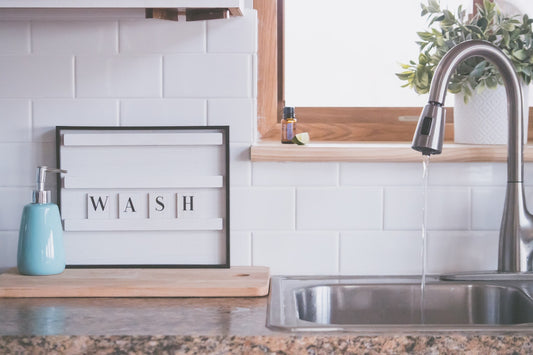A water softener resin is some sort of medium -- usually a bead -- that attracts magnesium and calcium, the two minerals that make up the majority of hard water, so that the magnesium and calcium binds to the bead.
In this article, we’re going to be looking at them more closely in a variety of applications. We’ll be answering some common questions like:
What are Water Softener Resin Beads Made Out Of?
Are Resin Beads Toxic?
How Expensive are Water Softener Resin Beads?
Where Can I Find a Water Softer Resin Replacement?
How Long Does Water Softener Resin Media Last?
After you finish reading this, you’ll know everything you need to know about resin in order to be an informed water softener customer.
What are Water Softener Resin Beads Made Out Of?
There are two primary materials that make up most resin beads: polystyrene, which is a variety of plastic common in a lot of consumer applications from K-Cups to styrofoam, and divinylbenzene, or DVB. DVB works to bond the polystyrene. It’s a clear yellow liquid with a strong odor.
If, after installing your water softener, your water smells even worse than before (and/or it’s a different color), it’s probably the DVB from the resin beads, which can leak into your water supply.
As we mentioned, these two materials make up most resin beads, which are about .3 to 1mm in size. To give you a frame of reference, a grain of rice is about 1.5mm thick -- so these beads are not very big at all.
But what happens if they do end up in your water? Or even in such small amounts that you don’t even notice? Are you going to get sick? Are resin beads toxic?
Are Resin Beads Toxic?
When something’s made up of materials like polystyrene and DVB, it’s natural to think that they’re might be a problem with ingesting them. However, that doesn’t mean that resin beads are toxic.
However, that doesn’t mean that they’re always safe if they’re leaking into your drinking water. Make sure to contact a professional as soon as possible to have your softener fixed -- or look into alternatives like template assisted crystallization systems at FilterSmart. Resin beads are still made of plastic -- no one should ever consume inorganic plastic if it can be avoided.
And, also, plastic is susceptible to all sorts of damage. If you’ve ever seen what a swimming pool can do to a kid’s toy over time, you get the idea. Chlorine can eventually wear down resin beads over time.
So, now that you know you should protect resin beads from damage, how expensive is the resin, exactly? The recurring costs are adding up at this point: from salt to wastewater to electricity, but how much can you expect to spend on the resin?
How Expensive are Water Softener Resin Beads?
Right off the bat, the service fee will range anywhere from $100 to $150 if you have to replace your resin beads. One cubic foot of the cheapest resin beads we could find go for about $130 on Amazon, so you’re looking at anywhere from $200 to $350 to change your water softener resin, and that’s on the low end.
But resin bead replacements aren’t anything like salt replacements, right? You won’t have to be replacing the full resin bed every other week. But, with that said…
How Long Does Water Softener Resin Media Last?
Good resin beads will last about 10 to 15 years depending on a few factors. Again, that’s assuming that nothing goes wrong. If you have serious hard water issues, you might have to replace the resin beads more frequently. If your city uses strong chemicals to get rid of serious water contamination issues, your beads probably won’t make it to their maximum lifespan.
What Alternatives Exist Outside of Standard Resin Beads?
Resin beads are a requirement for ion exchange systems because magnesium, calcium, and sodium need a negatively charged surface to bind to. Without the resin beads, ion exchange salt-based water softeners will not function as well as they should -- if at all.
On the other hand, if you want to reduce your spending on residual costs, you could look into something like template assisted crystallization. Our FilterSmart systems use a carbon block, which is all you’ll have to replace in two to three years, also depending on the level of chlorine in your water.
But with FilterSmart, that’s all you’ll have to replace. Within the first year of owning an ion-exchange salt-based water softener, you’ll spend more than we charge for our carbon blocks on salt alone. That’s not even factoring in the resin you’ll eventually have to replace, the water that the system wastes, and the electricity the system uses.
Conclusion: Water Softener Resin: Everything You Need to Know
Water softener resin is an inorganic plastic made of polystyrene and divinylbenzene, or DVB. Polystyrene is common in a lot of consumer products and materials, from K-Cups to styrofoam. DVB just works to bind the polystyrene, but it does have a strong scent.
Resin beads last a pretty long time, but you’ll have to replace them every ten years or so (on top of all the other maintenance associated with ion exchange systems, like regular salt replacements). The service itself will cost anywhere from $100-$150 and a cubic foot of resin media will cost about $130-$200. We should note that this is roughly half of the cost of a brand new system that you could buy at FilterSmart.
In fact, the only thing you’ll have to replace in a TAC system is the carbon block. Most people, as we’ve written about in the past, spend $400 annually on salt alone. The highest-end, industry-standard catalytic carbon from Jacobi is only going to set you back about $250 or so.
So, if you don’t want to deal with all of the issues associated with resin, and the increased maintenance, give our systems a shot. They come with a lifetime warranty.






